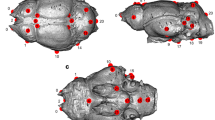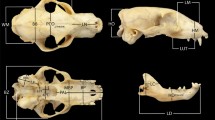Abstract
Morphology is not a reliable specific indicator in nocturnal animals. Nevertheless, because species are genetically independent, appropriate analytic methods should reveal subtle and consistent morphological differences among them. Until recently, the diversity of living bush babies was underrated, and new species have been recognized on the basis of genetic, behavioral and soft tissue data. This has placed museum curators in a quandary as to how to sort their skin and skull collections according to the new specific designations.
We conducted multivariate analyses of 6 morphologically similar pairs of bush baby taxa: Otolemur crassicaudatus and O. garnettii; Galagoides demidoffand G. thomasi; Galago gallarumand G. senegalensis; G. moholi and G. senegalensis; Euoticus elegantulus and E. pallidus, and Galagoides zanzibaricus and G. granti. We also compared subspecies within the taxa Otolemur crassicaudatus, O. garnettii, Galagoides demidoff, and Galago senegalensis.
Five out of six species pairs were discriminated with a high level of reliability (88.5–99%) on the basis of 2–5 morphological variables. Only Euoticus elegantulus and E. pallidus did not show this pattern. All strongly supported specific discriminations share two features: (a) ear length is a highly significant factor, while the involvement of other characters is variable; (b) the greater the reliability of the discrimination, the fewer variables necessary to effect it. Euoticus elegantulus and E. pallidus behaved more like subspecies in the discrimination, while Galago senegalensis sspp. showed a pattern of variation similar to that in the specific analyses.
Similar content being viewed by others
REFERENCES
Albrecht, G. H., and Miller, J. M. A. (1993). Geographic variation in primates: A review with implications for interpreting fossils. In Kimbel, W. H., and Martin, L. B. (eds.), Species, Species Concepts, and Primate Evolution, Plenum Press, New York.
Anderson, M. J. (1988). Comparative morphology and speciation in galagos. Folia Primatol. 69 (suppl. 1): 325–331.
Anderson, M. J. (2000). Penile morphology and classification of bush babies (subfamily Galagoninae). Int. J. Primatol. 21: 815–836.
Bearder, S. K. (1974). Aspects of the Ecology and Behaviour of the Thick-tailed Bushbaby, Galago crassicaudatus. Ph.D. thesis, University of the Witwatersrand, Johannesburg.
Bearder, S. K. (1999). Physical and social diversity among nocturnal primates: A new view based on long term research. Primates 40: 267–282.
Bearder, S. K., Honess, P. E., and Ambrose, L. (1995). Species diversity among galagos with special reference to mate recognition. In Alterman, L., Izard, M. K., and Doyle, G. A. (eds.), Creatures of the Dark: The Nocturnal Prosimians, Plenum Press, New York.
Bearder, S. K., Honess, P. E., Bayes, M., Ambrose, L., and Anderson, M. (1996). Assessing galago diversity-a call for help. African Primates 2: 11–15.
Booth, A. H. (1955). Speciation in the mona monkeys. J. Mammal. 36: 434–449.
De Boer, L. E. M. (1973). Cytotaxonomy of the Lorisoidea (Primates: Prosimii). I. Chromosome studies and karyological relationships in the Galagidae. Genetica 44: 155–193.
Dixson, A. F., and Van Horn, R. N. (1977). Comparative studies of morphology and reproduction in two subspecies of the greater bushbaby, Galago crassicaudatus crassicaudatus and G. c. argentatus. J. Zool. Lond. 183: 517–526.
Eaglen, R. H., and Simons, E. L. (1980). Notes on the breeding biology of thick-tailed and silvery galagos in captivity. J. Mammal. 61: 534–537.
Groves, C. P. (1974). Taxonomy and phylogeny of prosimians. In Martin, R. D., Doyle, G. A., and Walker, A. C. (eds.), Prosimian Biology, Duckworth, London.
Groves, C. P. (1989). A Theory of Human and Primate Evolution, Clarendon Press, Oxford.
Hair, J. F. Jr, Anderson, R. E., Tatham, R. L., and Black, W. C. (1992). Multivariate Data Analysis, Macmillan, New York.
Harcourt, C. S. (1984). The Behaviour and Ecology of Galagos in Kenyan Coastal Forest. Ph.D. thesis, University of Cambridge, Cambridge.
Hayman, R. W. (1937). A note on Galago senegalensis inustus Schwarz. Ann. Mag. Nat. Hist. (Ser. 10) 20: 149–151.
Hill, W. C. O. (1953). Primates: Comparative Anatomy and Taxonomy, Vol. I. Strepsirhini, University of Edinburgh Press, Edinburgh.
Jenkins, P. D. (1987). Catalogue of Primates in the British Museum (Natural History) and Elsewhere in the British Isles, Part IV: Suborder Strepsirrhini, Including the Subfossil Madagascan Lemurs and Family Tarsiidae, British Museum (Natural History), London.
Kingdon, J. (1971). East African Mammals, Vol. I, Academic Press, London.
Kingdon, J. (1997). The Kingdon Field Guide to African Mammals, Academic Press, London.
Masters, J. (1986). Geographic distributions of karyotypes and morphotypes within the greater galagines. Folia primatol. 46: 127–141.
Masters, J. C. (1991). Loud calls of Galago crassicaudatus and G. garnettii and their relation to habitat structure. Primates 32: 153–167.
Masters, J. C. (1993). Primates and paradigms: Problems with the identification of genetic species. In Kimbel, W. H., and Martin, L. B. (eds.), Species, Species Concepts, and Primate Evolution, Plenum, New York.
Masters, J. C. (1998). Speciation in the lesser galagos. Folia primatol. 69 (suppl. 1): 357–370.
Masters, J. C., and Dunn, D. (1988). Distribution of erythrocytic allozymes in two sibling species of greater galago [Galago crassicaudatus E. Geoffroy 1812 and G. garnettii (Ogilby 1838)]. Am. J. Primatol. 14: 235–245.
Masters, J. C., and Lubinsky, D. (1988). Morphological clues to genetic species: Multivariate analysis of greater galago sibling species. Am. J. Phys. Anthropol. 5: 181–196.
Masters, J. C., and Spencer, H. G. (1989). Why we need a new genetic species concept. Syst. zool. 38: 270–279.
Masters, J. C., Stanyon, R., and Romagno, D. (1987). Standardized karyotypes for the greater galagos, Galago crassicaudatus E. Geoffroy, 1812 and G. garnettii (Ogilby, 1838) Primates: Prosimii). Genetica 75: 123–129.
Mayr, E. (1963). Animal Species and Evolution. Belknap Press, Cambridge, Mass.
Mayr, E. (1969). Principles of Systematic Zoology. McGraw-Hill, New York.
Nash, L. T., Bearder, S. K., and Olson, T. R. (1989). Synopsis of Galago species characteristics. Int. J. Primatol. 10: 57–80.
Olson, T. R. (1979). Studies on Aspects of the Morphology of the Genus Otolemur, Ph.D. thesis, University of London, London.
Olson, T. R. (1986). Species diversity and zoogeography in the Galagidae (abstract). Primate Report 14: 213.
Paterson, H. E. H. (1993). Evolution and the Recognition Concept of Species, Johns Hopkins University Press, Baltimore.
Pasztor, L. M., and VanHorn, R. N. (1977). Intraspecific chromosomal variation within Galago crassicaudatus (Galaginae). J. Hum. Evol. 6: 569–573.
Poorman, P. A. (1982). Banded chromosomes of Galago crassicaudatus monteiri, G. c. garnettii, and a subspecific hybrid. Cytogenet. Cell Genet. 34: 296–304.
Ravosa, M. J. (1998). Cranial allometry and geographic variation in slow lorises (Nycticebus). Am. J. Primatol. 45: 225–243.
Schwarz, E. (1931). On the African long-tailed lemurs or galagos. Ann. Mag. Nat. Hist. (Ser. 10) 7: 41–66.
Smithers, R. H. N., and Wilson, V. J. (1979). Check List and Atlas of the Mammals of Zimbabwe Rhodesia. The Trustees of the National Museums and Monuments, Salisbury (Harare).
Zimmermann, E. (1990). Differentiation of vocalizations in bushbabies (Galaginae, Prosimiae, Primates) and the significance for assessing phylogenetic relationships. Z. Zool. Syst. Evolut.-forsch. 28: 217–239.
Zimmermann, E., Bearder, S. K., Doyle, G. A., and Andersson, A. B. (1988). Variations in vocal patterns of Senegal and South African lesser bushbabies and their implications for taxonomic relationships. Folia primatol. 51: 87–105.
Author information
Authors and Affiliations
Rights and permissions
About this article
Cite this article
Masters, J.C., Bragg, N.P. Morphological Correlates of Speciation in Bush Babies. International Journal of Primatology 21, 793–813 (2000). https://doi.org/10.1023/A:1005590524932
Issue Date:
DOI: https://doi.org/10.1023/A:1005590524932




